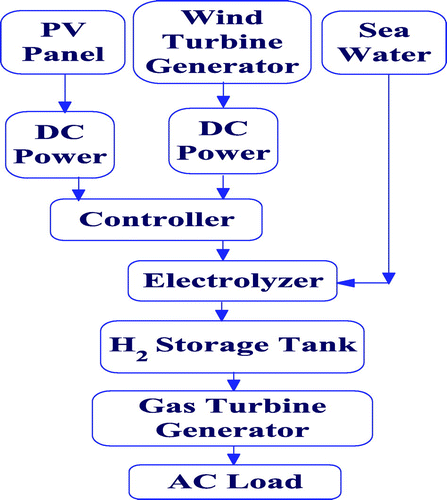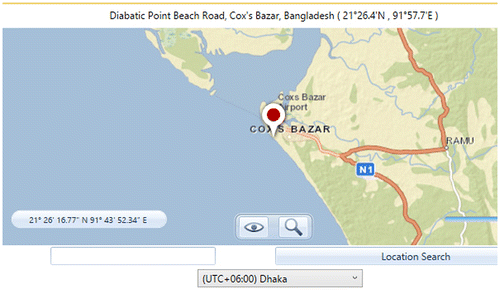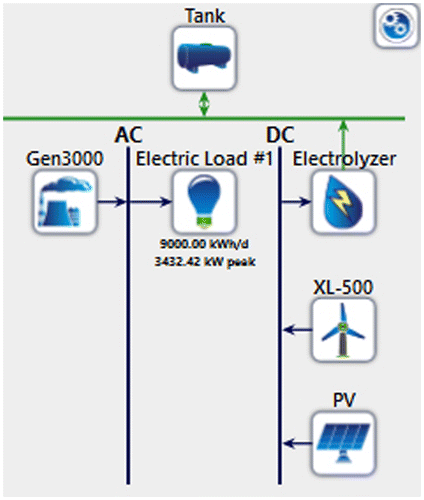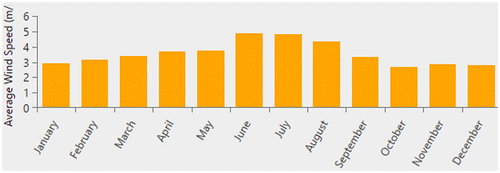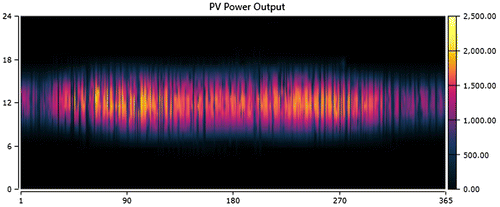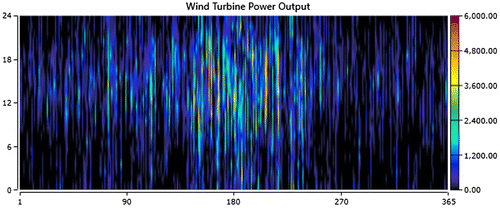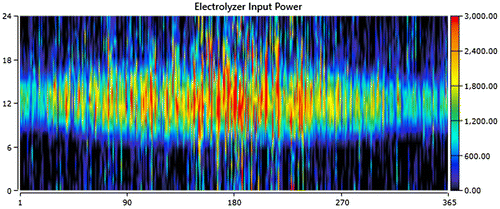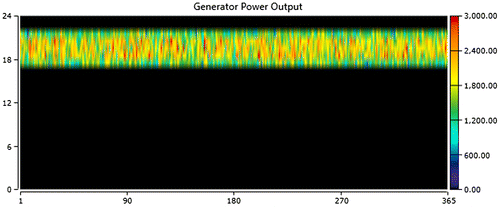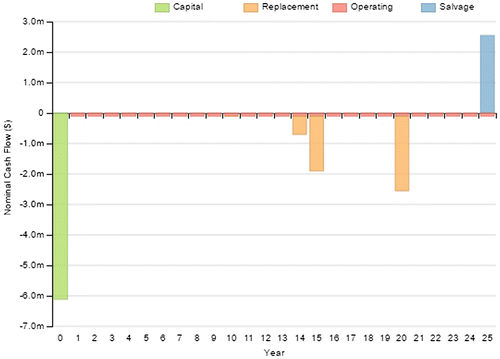 ?Mathematical formulae have been encoded as MathML and are displayed in this HTML version using MathJax in order to improve their display. Uncheck the box to turn MathJax off. This feature requires Javascript. Click on a formula to zoom.
?Mathematical formulae have been encoded as MathML and are displayed in this HTML version using MathJax in order to improve their display. Uncheck the box to turn MathJax off. This feature requires Javascript. Click on a formula to zoom.Abstract
Hydrogen energy is one of the favorite choice to alternative power generation around the world. Renewable energy is the best scope to produce alternative power. Because resources are available and doesn’t make any green house effect. In this reason to establish a renewable resources (solar, wind) based hybrid system with sea water electrolysis by Proton exchange membrane (PEM) electrolyzer for the production of Hydrogen. In this proposed system PV & Wind power use for sea water electrolysis and storage Hydrogen. To meet the peak load demand Gas Turbine Generator used to produce electricity using storage Hydrogen fuel. For design, optimization & peak load demand we have chosen Diabatic beach, Kolatoli Cox’s Bazar where wind flow, solar radiation and sea water are available.
Public Interest Statement
At 21st century, the importance of energy demand does not require any explanation. World’s major power generation sources fossil fuel are in saturation period. Even though, nuclear power plant is being capable of yielding huge amount of power. However, due to dangers associated with nuclear power plant, electricity production is quite risky for society. So, renewable energy is the best choice for alternating power generation to overcome power crisis and it is environment friendly. In This article proposed a hydrogen sea shore based hybrid power system for Cox’s Bazar, Bangladesh for overcame the power crisis. The main objectives of this article is design and simulation of a hybrid system also creating different scope for producing hydrogen fuel because hydrogen fuel is the future fuel for power generation and transport section..
1. Introduction
A developing country like Bangladesh is experiencing scarcity of efficient electricity production system. Currently, about 72% of the total population has access to electricity including public & private sectors (Ministry of Power, Citation2016). Main sources of electricity production in Bangladesh are natural gas: it’s about 66% and others are oil, hydropower and coal (CitationAn overview of power sector of Bangladesh, 2011). The gas reserve will be expended in next 10–20 year. In 2016 our total daily generation is 8,900 MW and production capacity 12,725 MW (Bangladesh Power Development Board, Citation2016). After 15 year in 2030 our demand will be 30,000 MW. So it’s very necessary for us to improve our power generation capacity. To overcome this situation, government has taken necessary steps. For instance, establishing various power plants which are non-renewable; such as oil, gas, and coal based plants, and many more. In addition, government has taken steps to establish a 1,000 MW nuclear power plant in Ruppur. But nuclear power needs a huge technological safety. If any kinds of disaster happen we can’t handle it because of our lack of technical ability. Government has taken steps to establish 1,320 MW thermal coal based plant in Rumpal & 1,200 MW plant in Moheshkhali also 1,200 MW plant in Baskhali. It’s also harmful for our nature. To meet the growing electricity demand Government also has taken furnace oil based quick rental power plant for quickly solving power crisis but per units cost of this types of power plant is high. It has negative environmental effects. So we can’t effort these types of power plant longer period. The power sector alone contributes to 40% of total CO2 emissions in Bangladesh (Shrestha, Anandarajah, & Liyanage, Citation2009). So it is very necessary for us to invent new source of energy for solving national power crisis. Therefore, renewable energy is one of the best efficient choices for overcoming this power crisis. As renewable sources are natural and environment friendly and doesn’t create any kind of disaster. In Bangladesh, about 72% of the population lives in the rural areas and renewable energy is providing clean energy (Chowdhury, Reza, Nitol, & Mahabub, Citation2012).
To overcome this situation, hydrogen economy is one of the best solutions to the world’s future energy and plays an important role as an energy carrier. In near future Hydrogen may be converted into useful forms of energy more efficiently than fossil fuels (Veziroglu, Citation1998). In addition, water electrolysis technology is one way to produce hydrogen (FreedomCAR and fuel partnership, Citation2009). Proton exchange membrane (PEM) Electrolyzer becomes known as one of the most clean to produce hydrogen and talented alternatives to reduce fossil fuel dependency (Kunusch, Puleston, Mayosky and Husar, Citation2011). As hydrogen is a green fuel so there is no (CO2) carbon emission. In Kolatoli, Cox’s Bazar annual average solar radiation of 4.77 kWh/m2/day and rate of average wind speed is 3.55 m/s. Sea water also available in Cox’s Bazar because Cox’s Bazar one of the coastal areas in Bangladesh To meet the peak load demand in a day which is 9 MW and the demand schedule are 5–10 PM So the total demand in a year is 3,285 MWh/yr (Ambia, Islam, Shoeb, Maruf, & Mohsin, Citation2010).
2. System methodology
To establish a green energy system we have used two renewable energy (solar and wind). When sun radiation falls on the PV panel, it will produce direct current and when wind flow rotate the turbine connected to DC Generator it also produce dc power too. Both powers will control by a controller for requirement of PEM electrolyzer input power. PEM electrolyzer will produce Hydrogen (H2) using sea water. Then Hydrogen will Store by a tank. To meet the peak load demand Gas Turbine Generator will use to produce electricity by source of hydrogen (H2) fuel.
Figure represented the block diagram of the system. The major objective of this proposed system to be able to meet the peak load demand in Kolatoli, Cox’s Bazar. HOMER PRO software uses the calculations, analysis, simulations of the system.
3. Proposed hybrid green system
The propose hybrid green system consists of two renewable sources (solar, wind), hydrogen storage tank, peak load, gas turbine generator, and sea water which is used for producing hydrogen by electrolyzer.
The proposed hybrid system model & geographical location is situated at 22 degrees 26 min North latitude and 91 degrees 57 min East longitude at Diabatic beach, Cox’s Bazar, Bangladesh which is also near the Cox’s Bazar international airport. Table Shown proposed system component specification and Figures and . Showed proposed hybrid system model and location.
Table 1. Proposed system component specification
4. Resources analysis
4.1. Photovoltaic energy
PV cell converts light energy into the electrical energy. Sun radiation fall into the panel then PV cell material and electrons are emitted from the atoms then they are outspread. Solar cell released current created solar power converted into electrical power (Power Cell, Ministry of Power, Bangladesh, Citation2016). PV module coverts only 40% of sunlight radiation to Electrical power (Lipu, Citation2013). The PV system gives DC Power as a output. The PV output power can be calculated according to the following equation:
(1)
(1)
where, x = solar radiation, P = power generation, and A, B, C are constants, which can be derived from measured data.
4.2. Wind energy
Wind energy converted into electricity by using the kinetic energy into mechanical energy (Lipu, Citation2013). When air flow comes to wind turbine propellers, its rotated then converts mechanical power into electrical power. According to Betz limit, wind turbine can convert only 59% air energy into electricity. The output for a wind generator is given
(2)
(2)
where A = area perpendicular to the direction of flow (in m2), v = wind velocity (m/s), ρ = density of air (in kg/m3) and P = power generation.
Maximum power efficiency of any types of wind turbine is 0.59. This is called the “power coefficient”
(3)
(3)
4.3. Sea water electrolysis
The main purpose of the sea water electrolysis is to produce hydrogen (H2). PEM Electrolyzer used for producing Hydrogen. Electrolysis of water is its decomposition to give hydrogen and oxygen gases due to the passage of an electric current. The chemical process of electrolysis (Potential of micro hydro power units in Bangladesh, Citation2012) are given below:
The reaction at the cathode is:
(4)
(4)
The reaction at the anode is:
(5)
(5)
The overall reaction is as follows:
(6)
(6)
Reduction of Na + (E° = –2.7 V) is energetically more difficult than the reduction of water (–1.23 V).
4.4. Data analysis
Cox’s Bazar Diabatic beach is located at 21 degrees 26.4 min North latitude and 91 degrees 57.7 min East longitude. One year wind speed and solar radiation collected from NASA (Kabir, Nath, Mazumder, & Islam, Citation2016; NASA surface meteorology and solar energy, Citation2016). Table shows the Solar Global Horizontal Irradiance (GHI) value & wind speed for Cox’s Bazar.
Table 2. Solar GHI value & wind speed data for Cox’s Bazar
5. Simulation & results
5.1. System component specifications for simulation
For simulate and calculate the hybrid system using HOMER Pro software (HOMER energy, Citation2016; Lambert, Gilman, & Lilienthal, Citation2006).
The proposed solar panel capacity is 2,200 kW which is shown in Table and Figure presents the solar radiation data.
Table 3. PV cell specification
The wind turbine capacity (500 kw × 9) = 9 kW which is shown in Table and Figure presents wind speed data.
Table 4. Wind turbine generator specification
The capacity of storage tank is 50,000 kg and PEM electrolyzer capacity is 300 kW which shown in Table . The capacity of gas turbine generator is 3,000 kw and uses fuel is hydrogen, fuel lower heating value is 120 MJ/kg which is shown in Table . Electrical peak load demand in patenga is 9 MW and demand duration are 6–10 PM which shown in Table .
Table 5. Storage tank & electrolyzer specification
Table 6. Gas turbine generator
Table 7. Electrical peak load demand
5.2. Simulation results
The rated capacities of the PV Cells are 2.2 MW and total electricity production is 3,263.389 MWh/yr. The mean output is 0.373 MW. The per unit cost of energy of the PV system is 0.039$/kWh which is shown in Table and hourly electricity production curve showed in Figure .
Table 8. PV system output power
The capacities of the wind turbine generators are 4.5 MW and total electricity production is 3,424.742 MWh/yr and the mean output is 0.391 MW. The per unit cost of energy of the wind system is 0.04$/kWh which is shown in Table and hourly electricity production curve showed in Figure .
Table 9. Wind turbine generator power
The rated capacity of the PEM electrolyzer is 3 MW. The Input power of the Electrolyzer is 6,499.506 MWh/yr which is supplied by solar & wind output power. Using sea water Electrolyzer produced H2. Total Hydrogen is produced 1,400,659.79 kg/yr and the mean H2 is 15.99 kg/yr. Tables and presents PEM electrolyzer input power and H2 production output. Figure . Shows electrolyzer input power. Figure Shows hydrogen production curve.
Table 10. PEM electrolyzer input power
Table 11. H2 production output
The rated capacity of the gas turbine generator is 3 MW. The operation schedule are (5–10) PM/day. Hydrogen consumed 137,803 L/yr. The production of the electricity is 3,281.028 MWh/yr which target peak load demand in patenga. Gas turbine generator output details Shows in Table and Figure . Total Electricity Production and Hydrogen Consumption details shows in Tables and . Figure shows full system electricity production details.
Table 12. Gas turbine 3 MW generator output
Table 13. Total electricity production
Table 14. Total hydrogen consumption
6. System costs
The initial cost of the system is very high about $6,115,000. After 15 year Electrolyzer needs to replace and after 20 year also needs to replace PV cell & Wind turbine and total costs of the system are $9,240,844. The annual cost is $388,195. Table and Figure presents the overall system cost details.
Table 15. Overall system costs
7. Conclusions
The proposed hybrid system will create new revolution in power sector. The system is completely green and won’t emit any CO2 & pollution and won’t create any green house gas, also provides pure alternating current & won’t provide any harmonics and distortion also doesn’t need any power electronic devices like inverter which produce ripple factor. This hybrid system is designed for contributing in peak load demand in Kolatoli area in Cox’s Bazar. The target load demand is 9 MWh/day and total demand in a year is 3,281.03 MWh/yr. To fulfill the target demand gas turbine generator needed 137,803 kg/yr and in this system produced hydrogen is about 140,060 kg/yr. The initial cost of the system is huge about $6,115,000 and per unit cost of energy of the system is 0.178$/kWh which is better than quick rental fuel based power plant in Bangladesh. So Access fuel could be used to transport & cooking sector.
Funding
The authors received no direct funding for this research.
Cover image
Source: Authors.
Acknowledgment
The authors are grateful to the Renewable Energy Research Lab, Department of Electrical & Electronic Engineering (EEE) and Institute of Energy Technology (IET), at Chittagong University of Engineering & Technology (CUET), Chittagong, Bangladesh for the support to carry out the research work reported in this paper.
Additional information
Notes on contributors
Kazi Meharajul Kabir
Kazi Meharajul Kabir has received his BSc in EEE from University of Science & Technology Chittagong (USTC) also student of MSc in Energy Technology from Chittagong University of Engineering and Technology (CUET), Chittagong 4349, Bangladesh. He is a member of the Institute of Electrical and Electronics Engineers (IEEE) since 2013, His research area includes Renewable energy, Power Generation, Micro Grid & Smart Grid, Control & Automation.
References
- Ambia, M. N., Islam, M. K., Shoeb, M. A., Maruf, M. N. I., & Mohsin, A. S. M. (2010). An analysis & design on micro generation of a domestic solar-wind hybrid energy system for rural & remote areas-perspective Bangladesh (pp. 107–110). 2nd International Conference on Mechanical and Electronics Engineering, Kyoto.
- An overview of power sector of Bangladesh. (2011, November). Bangladesh Power Development Board: Dhaka.
- Bangladesh Power Development Board. (2016). Retrieved from www.https://www.bpdb.gov.bd/bpdb
- Chowdhury, N. R., Reza, S. E., Nitol, T. A., & Mahabub, A. A. F. I. (2012). Present scenario of renewable energy in Bangladesh and a proposed hybrid system to minimize power crisis in remote areas. International Journal of Renewable Energy Research, 2, 280–288.
- Kunusch, C., Puleston, P. F., Mayosky, M. A., & Husar, A. P. (2011, September). Control-oriented modeling and experimental validation of a PEMFC generation system. IEEE Transactions on Energy Conversion, 26, 851–861.
- FreedomCAR and fuel partnership: Hydrogen production overview of technology options. (2009). Retrieved May 8, 2013, from https://www1.eere.energy.gov/hydrogenandfuelcells/pdfs/h2_production_roadmap.pdf
- HOMER energy. (2016). Retrieved November 30, 2016 from https://homerenergy.com
- Kabir, K. M., Nath, A., Mazumder, S., & Islam, M. O. (2016). Modelling & simulation of a grid connected hybrid power plant with solar, wind & diesel power for Cox’s Bazar. 2nd International Conference on Electrical, Computer & Telecommunication Engineering (ICECTE), Bangladesh, pp. 1–4. doi:10.1109/ICECTE.2016.7879575
- Lambert, T., Gilman, P., & Lilienthal, P. (2006). Micropower system modeling with HOMER. Integration of Alternative Sources of Energy, 379–418.
- Lipu, M. S. H. (2013). A feasibility study of solar-wind-diesel hybrid system in rural and remote areas of Bangladesh. International Journal of Renewable Energy Research, 3, 892–900.
- Meier, K. (2014). Hydrogen production with sea water electrolysis using Norwegian offshore wind energy potentials. International Journal of Energy and Environmental Engineering, 5, 104.
- Ministry of Power. (2016). Energy and mineral resources, government of the peoples Republic of Bangladesh. Retrieved August 29, 2015, from www.powerdivision.gov.bd/user/brec1/30/1
- NASA surface meteorology and solar energy. (2016). Retrieved from https://eosweb.larc.nasa.gov
- Potential of micro hydro power units in Bangladesh. (2012). Retrieved from https://www.lged-rein.org/
- Power Cell, Ministry of Power, Bangladesh. (2016). Retrieved August 29, 2015, from https://www.powercell.gov.bd
- Shrestha, R. M., Anandarajah, G., & Liyanage, M. H. (2009). Factors affecting CO2 emission from the power sector of selected countries in Asia and the Pacific. Energy Policy, 37, 2375–2384.10.1016/j.enpol.2009.01.032
- Veziroglu, T. N. (1998). Hydrogen Energy Technologies, UNIDO-Emerging Technologies Series. Vienna: United Nations Industrial Development Organization.

